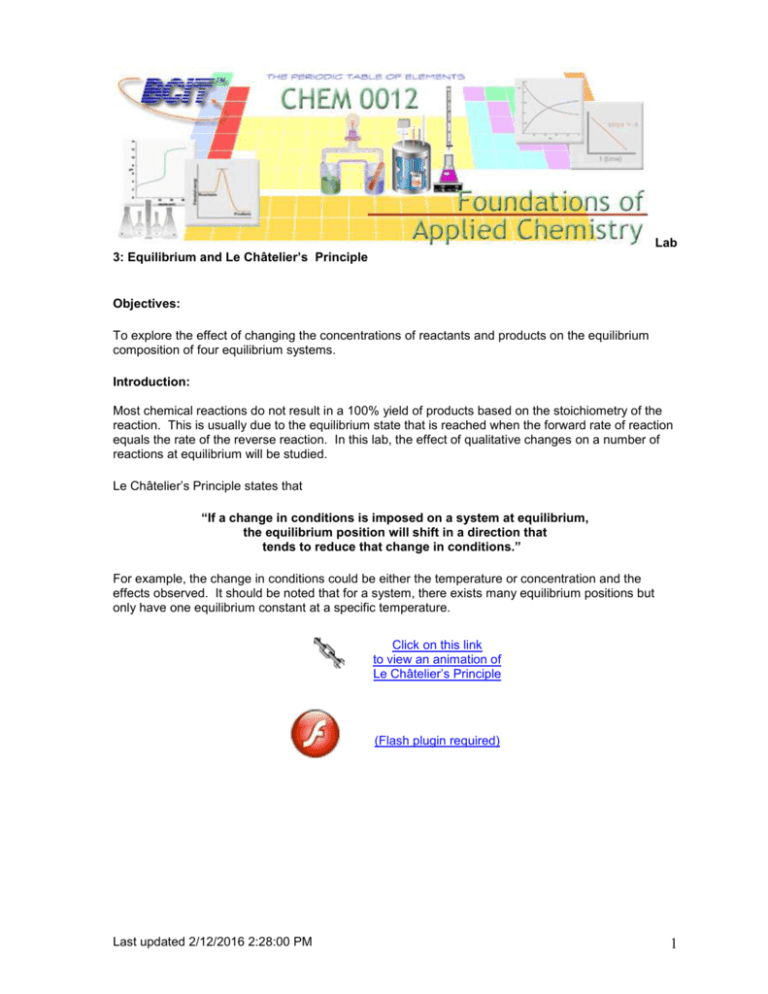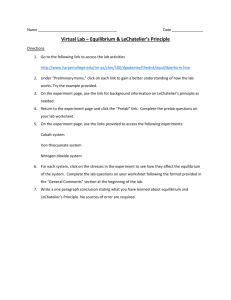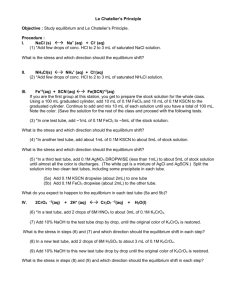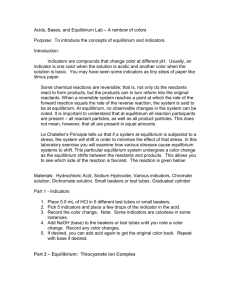Part D: The Equilibrium of an Acid
advertisement

Lab 3: Equilibrium and Le Châtelier’s Principle Objectives: To explore the effect of changing the concentrations of reactants and products on the equilibrium composition of four equilibrium systems. Introduction: Most chemical reactions do not result in a 100% yield of products based on the stoichiometry of the reaction. This is usually due to the equilibrium state that is reached when the forward rate of reaction equals the rate of the reverse reaction. In this lab, the effect of qualitative changes on a number of reactions at equilibrium will be studied. Le Châtelier’s Principle states that “If a change in conditions is imposed on a system at equilibrium, the equilibrium position will shift in a direction that tends to reduce that change in conditions.” For example, the change in conditions could be either the temperature or concentration and the effects observed. It should be noted that for a system, there exists many equilibrium positions but only have one equilibrium constant at a specific temperature. Click on this link to view an animation of Le Châtelier’s Principle (Flash plugin required) Last updated 2/12/2016 2:28:00 PM 1 In this experiment, we will study the equilibrium of four systems and observe the reaction of the equilibrium systems as predicted by Le Châtelier’s Principle. The four systems are: Part A - The Equilibrium of Co(II) Complex Ions The element cobalt can form compounds in two different oxidation states, +2 and +3. The +2 state is more common. The chloro complex of cobalt (II), CoCl 42-, is tetrahedral while the aquo complex of cobalt (II), Co(H2O)62+, is octahedral. Both of these complexes exhibit different colours. Cobalt complexes are used as drying agents with the colour change indicating when the drying agent should be changed. The equilibrium reaction is: Co(H2O)62+ (aq) + 4 Cl- (aq) pink CoCl42- (aq) + 6 H2O (l) blue ΔH = +50 kJ (3-1) Part B - The Equilibrium of the thiocyano-iron(III) complex ion When colourless aqueous solutions of iron (III) ion, Fe 3+, and thiocyanate ion, SCN-, are combined, the reaction that occurs produces the thiocyanoiron (III) complex ion, FeSCN 2+, which is responsible for the equilibrium mixture's deep red colour. Fe3+ (aq) + SCN- (aq) colourless colourless FeSCN2+ (aq) red-brown (3-2) The colour of the thiocyanoiron (III) complex ion, FeSCN2+, solution will indicate how the equilibrium system is being affected. Part C - The Equilibrium of a Mg+2 precipitate Reactions which form precipitates are written as an equilibrium reaction using the solubility product. If there is a precipitate MX, then the Ksp expression is: MX (s) M+(aq) + X-(aq) (3-3) Part D: The Equilibrium of an Acid-Base Indicator An acid-base indicator can be used to observe an equilibrium reaction. Indicators are weak acids which show one colour in the acid form, HInd, and another colour in the basic form, Ind-. At the pKa of the indicator there is equimolar amounts of the conjugate forms and the observed colour is a mixture of the two. Bromothymol blue is a yellow-green-blue indicator which has a pKa of 7.0. The reaction of the indicator bromothymol blue can be illustrated as follows: HInd (aq) yellow Last updated 2/12/2016 2:28:00 PM H+ (aq ) + Ind- (aq) blue (3-4) 2 Apparatus: 1. Large test tubes 2. Hot plate (1 per student) Solutions: 1. 2. 3. 4. 5. 6. 7. 8. 9. 10. 11. 12. 13. 14. 15. 16. 17. 0.1 M CoCl2·6H2O (15 mL per student) concentrated HCl (place in fumehood) 0.1 M AgNO3 0.1 M Mg(NO3)2 6M NH4OH NH4Cl solid pH 7 buffer solution (3 mL per student) Bromothymol blue indicator 0.1 M Fe(NO3)3 in 0.1M HNO3 (2 mL per student) 1 M Fe(NO3)3 in 0.1M HNO3 (0.1 mL per student) 0.1 M KSCN in 0.1M HNO3 (2 mL per student) 1 M KSCN in 0.1M HNO3 (0.1 mL per student) 0.1 M NaCl 6M NaOH ice 1 M HCl 1 M NaOH Last updated 2/12/2016 2:28:00 PM 3 Procedure: Part A - The Equilibrium of Co(II) Complex Ions 1. Obtain four clean and dry test tubes and label them Test tube #1, #2, #3 and Control. 2. Record the initial colour of the stock CoCl2· 6H2O solution. 3. Pour 12 mL of 0.1 M CoCl2· 6H2O into a clean, dry 50 mL beaker. In the fume hood, add concentrated HCl drop wise and mix with a glass rod until a permanent colour change is observed. Record the observed colour. 4. Divide the solution equally into four test tubes. Use the Control test tube for colour comparison. 5. In Test tube #1 add water with mixing until a colour change is produced. Record the observed colour. 6. Heat Test tube #1 in a hot water bath (add boiling chips) and you should see a colour change. (If you don’t then you have likely added too much water. Try again with another sample.) Record the observed colour. 7. Cool Test tube #2 in an ice water bath and record the observations. Record the observed colour. Keep your ice bath for Part B. 8. Heat Test tube #3 in a hot water bath and record your observations. Record the observed colour. Keep your water bath for Part B. 9. Dispose of the cobalt solutions in the waste bottle. Part B - The Equilibrium of the thiocyano-iron(III) complex ion You should compare the colour of each tube with the reference Test tube #1. Note the colour of the 0.1 M Fe(NO3)3. 1. In a 100 mL beaker, combine: o 1.5 mL of 0.1 M Fe(NO3)3, ** USE THE CORRECT CONCENTRATION** o 1.5 mL of 0.1 M KSCN, ** USE THE CORRECT CONCENTRATION** o 50 mL H2O. Pour 5 mL of the solution into nine numbered test tubes. 2. Add two drops of H2O to Test tube #1, which will serve as reference for colour. Record your observations. 3. Add two drops of 1M Fe(NO3)3 to Test tube #2. Record your observations. 4. Add two drops of 1M KSCN to Test tube #3. Record your observations. 5. Add 8 drops 6M NaOH to Test tube #4. The precipitate Fe(OH)3 will take a few minutes to form. Record your observations. 6. Add 4 drops of AgNO3 to Test tube #5. The precipitate is AgSCN. Record your observations. 7. Add 4 drops of 0.1 M NaCl to Test tube #6. Record your observations. Last updated 2/12/2016 2:28:00 PM 4 8. Place Test tube #7 in an ice water bath. Record observations. 9. Place Test tube #8 in a boiling water bath. Record observations. 10. Add 1 mL of distilled water to Test tube #9. Record your observations. 11. Now add an additional 4 mL of water and record your observations. 12. Dispose of the reagents as instructed. Part C - The Equilibrium of a Mg2+ precipitate 1. Into a test tube add: o 1 mL water, o 2 drops of 0.1 M Mg(NO3)2, and o 3 drops of 6M NH4OH. Record your observations. 2. Add a small amount (1/4 spatula) of solid NH4Cl to the test tube and mix to dissolve. Record your observations. What is the product? Consult a solubility table. Part D: The Equilibrium of an Acid-Base Indicator 1. Obtain a pH 7 buffer solution and pour 3 mL into a 50 mL beaker. Add 5 drops of bromothymol blue indicator. Record your observations. 2. Add 1 M HCl drop wise with mixing until the solution is acidic and the indicator shows a colour change. Record your observations. 3. Add 1M NaOH drop wise to return to the original colour and continue until the solution is basic and a new colour is reached. Record your observations. Last updated 2/12/2016 2:28:00 PM 5 Datasheet: Part A - The Equilibrium of Co(II) Complex Ions Solutions Colour CoCl2· 6H2O (step 2) CoCl2· 6H2O + HCl (step 3) Test tube #1 + H2O (step 5) Test tube #1 + H2O + heat (step 6) Test tube #2 + ice water bath (step 7) Test tube #3 + hot water bath (step 8) Last updated 2/12/2016 2:28:00 PM 6 Datasheet: Part B - The Equilibrium of the thiocyano-iron(III) complex ion Test tubes Observations Test tube #1 - Fe(NO3)3 + KSCN + H2O(step 2) Test tube #2 + 1 M Fe(NO3)3 (step 3) Test tube #3 + 1M KSCN (step 4) Test tube #4 + 6 M NaOH (step 5) Test tube #5 + 4 drops AgNO3 (step 6) Test tube #6 + 0.1 M NaCl (step 7) Test tube #7 + ice (step 8) Test tube #8 + boiling water bath (step 9) Test tube #9 + 1 mL distilled water (step 10) Test tube #9 + 5 mL distilled water (step 11) Last updated 2/12/2016 2:28:00 PM 7 Datasheet: Part C - The Equilibrium of a Mg2+ precipitate Test tubes Observations Mg(NO3)2 + NH4OH (step 1) Test tube + NH4Cl (step 2) Part D: The Equilibrium of an Acid-Base Indicator Solutions Observations pH 7 Buffer + bromothymol blue (HInd) (step 1) Solution + HCl (step 2) Solution + NaOH (step 3) Last updated 2/12/2016 2:28:00 PM 8 Postlab Questions: Part A - The Equilibrium of Co(II) Complex Ions 1. Write the equilibrium equation for step 3 when concentrated HCl was added to CoCl 2· 6H2O. Equilibrium reaction: 2 .In Step 5, circle the shift in equilibrium observed (if any) when water is added to Test tube #1. no shift in equilibrium shifts to the right shifts to the left 3. In Step 5, the colour of the solution is due to the presence of which ion? 4. In Step 6, circle the shift in equilibrium observed (if any) when Test tube #1 is heated. no shift in equilibrium shifts to the right shifts to the left 5. Circle the correct response. Which statement is true? heating favours an exothermic process heating favours an endothermic process 6. In Step 6, the colour of the solution is due to the presence of which ion? 7. In Step 7, circle the shift in equilibrium observed (if any) when Test tube #2 is in the ice bath. no shift in equilibrium shifts to the right shifts to the left 8. Circle the correct response. Which statement is true? cooling favours an exothermic process cooling favours an endothermic process 9. In Step 7, the colour of the solution is due to the presence of which ion? Last updated 2/12/2016 2:28:00 PM 9 10. In Step 8, circle the shift in equilibrium observed (if any) when Test tube #3 is in the hot water bath. no shift in equilibrium shifts to the right shifts to the left 11. Circle the correct response. Which statement is true? heating favours the equilibrium products heating favours the equilibrium reactants 12. In Step 8, the colour of the solution is due to the presence of which ion? Part B - The Equilibrium of the thiocyano-iron(III) complex ion 1. Write the equilibrium equation for step 1 when Fe(NO3)3, KSCN and water was combined. Equilibrium reaction: 2. In Step 2, circle the shift in equilibrium observed (if any) in Test tube #1 when 2 drops of water is added. no shift in equilibrium shifts to the right shifts to the left 3. In Step 3, circle the shift in equilibrium observed (if any) when Test tube #2 when 2 drops of 1 M Fe(NO3)3 is added. no shift in equilibrium shifts to the right shifts to the left 4. In Step 4, circle the shift in equilibrium observed (if any) when Test tube #3 when 2 drops of 1 M KSCN is added. no shift in equilibrium shifts to the right shifts to the left 5. In Step 5, circle the shift in equilibrium observed (if any) when Test tube #4 when 8 drops of 6 M NaOH is added. Last updated 2/12/2016 2:28:00 PM 10 no shift in equilibrium shifts to the right shifts to the left 6. In Step 6, circle the shift in equilibrium observed (if any) when Test tube #5 when 4 drops of AgNO3 is added. no shift in equilibrium shifts to the right shifts to the left 7. In Step 7, circle the shift in equilibrium observed (if any) when Test tube #6 when 4 drops of 0.1 M NaCl is added. no shift in equilibrium shifts to the right shifts to the left 8. In Step 8, circle the shift in equilibrium observed (if any) when Test tube #7 when it is placed in ice water bath. no shift in equilibrium shifts to the right shifts to the left 9. In Step 9, circle the shift in equilibrium observed (if any) when Test tube #8 when it is placed in hot water bath. no shift in equilibrium shifts to the right shifts to the left 10. In Step 10, circle the shift in equilibrium observed (if any) when Test tube #9 when 1 mL of water is added. no shift in equilibrium shifts to the right shifts to the left 11. In Step 11, circle the shift in equilibrium observed (if any) when Test tube #9 when 5 mL of water is added. no shift in equilibrium shifts to the right shifts to the left 12. Write the equilibrium constant expression and explain the observation when water is added. Last updated 2/12/2016 2:28:00 PM 11 Part C -The Equilibrium of a Mg2+ precipitate 1. Write the equilibrium equation (written as Ksp) for step 1 when Mg(NO3)2 and NH4OH was combined. Equilibrium reaction: 2 .In Step 2, circle the shift in equilibrium observed (if any) in the test tube when NH 4Cl is is added. no shift in equilibrium shifts to the right shifts to the left Part D -The Equilibrium of an Acid-Base Indicator 1. Write the equilibrium equation (written as Ka) for step 1 when the pH 7 buffer and 5 drops of bromothymol blue (HInd) is combined. Equilibrium reaction: 2 .In Step 2, circle the shift in equilibrium observed (if any) in the test tube when 1 M HCl is added to the solution. no shift in equilibrium shifts to the right shifts to the left 3 .In Step 3, circle the shift in equilibrium observed (if any) in the test tube when 1 M NaOH is added to the solution. no shift in equilibrium Last updated 2/12/2016 2:28:00 PM shifts to the right shifts to the left 12









